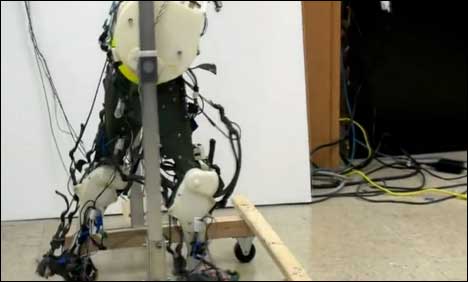
Video: Scientists Create Biologically Accurate Walking Robot Legs
From Truther
If you’re a Wallace and Gromit fan, you’ll want a look at this pair of robotic legs, which a group of researchers claim are the first to model walking in a biologically accurate manner.
No, you can’t wear them like Wallace did — these pants walk alone. But they do have features that imitate biological muscles, sensors and nervous-system control. The research, published today in the Journal of Neuroengineering by researchers from the University of Arizona, could help us understand how human babies learn to walk.

The robot’s legs are made from plastic using a 3D printer, and the ”muscles” consist of motors that pull on kevlar straps to bend and straighten the legs. Force sensors in the straps endow the robot with proprioception, the human body’s sense of its limb positions and movements.
To better mimic walking in humans, the computer that controls the legs acts like a central pattern generator, or CPG, the neural network in our spinal cords responsible for the rhythmic, mindless quality of walking. The researchers used a simple “half-center CPG” consisting of two signals firing alternately to flex and then extend each leg. The movement allows slight adjustments for sensory feedback, in a reflex-like manner.
The mechanical legs represent a simplified model of how real legs function. The legs can amble successfully at a range of walking frequencies, and the CPG signals greatly stabilize the walking movement, showing the importance of top-down control in the nervous system, as opposed to merely reflex-based control.
The robo-legs totter like a toddler in a baby walker, and the researchers suggest that babies might use a simple CPG like the robot’s, and develop more complex control patterns as they age.
VIEW VIDEO
